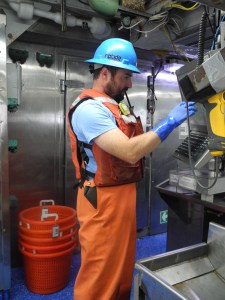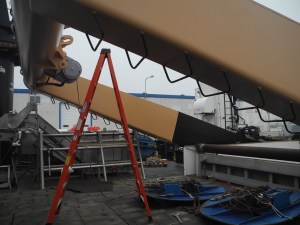NOAA Teacher At Sea
Amy Orchard
Aboard NOAA Ship Nancy Foster
September 14 – 27, 2014
Mission: Fish Tagging
Geographical area of cruise: Riley’s Hump: Tortugas Ecological Reserve South
Date: September 14, 15, 16, 2014
Weather: September 16, 2014 20:00 hours
Latitude 24° 30’ 30’’N Longitude 83° 09’ 9’’W
Few clouds, clear. Humidity 10%.
Wind speed 7 knots.
Air Temperature: 28° Celsius (83° Fahrenheit)
Sea Water Temperature: 30.4° Celsius (86.7°Fahrenheit)
SUNDAY:
Getting to Know the Nancy Foster
Scott Donahue, Science Coordinator for Florida Keys National Marine Sanctuary and Chief Scientist for this cruise, brought me aboard and gave me a tour of the Nancy Foster early in the day. Also there was Tim Olsen, Chief Engineer, who I had met on the plane from Atlanta to Key West. I was overwhelmed with the capacity of the ship. It is huge and fully equipped for a wide variety of scientific endeavors, diving, mapping, surveying, launching large equipment etc. I feel lucky to be a part of what is going on.
Click on these two photos for more information
Short Jaunt into Key West
After taking some time to see Key West, I headed back to the ship where I met Cammy Clark from the Miami Herald who will be with us for one week reporting on our experience. Cammy and I spent the night on the ship awaiting the science team to arrive early tomorrow morning. The ship is in dock so I can’t yet be sure if I will suffer from sea sickness. However, I hear that there is 100% survival rate if it does occur!
Click on these two photos for more information
MONDAY:
Meeting the Scientists
During the two weeks aboard, I will be working with 10 scientists from the Florida Fish and Wildlife Conservation Commission (FWC), 7 NOAA Florida Keys National Marine Sanctuary scientists and 2 ROV pilots from the University of North Carolina at Wilmington. I am excited to be a part this interagency collaboration. Seems like an efficient way to communicate and share experiences.
Guess which photo shows the scientists I will be working with…
Answer: PHOTO ON THE RIGHT. FWC scientists from left to right: Mike McCallister, Jeff Renchen,Danielle Morley, Ariel Tobin (in front), Ben Binder, Paul Barbera. Not as reserved or stodgy as you might picture a group of scientists, but they are incredibly knowledgeable and dedicated to their work. They are unbelievably cool people! They have amazing stories to tell, are easy-going and love to have a good time. I want to be like them when I grow up!
Preparing to Do Science
One of the many things we will do this week is tagging fish. To do this, we will travel away from the ship on small boats to set fish traps. Once the right fish are contained, the dive team will surgically insert an acoustic tag which will allow them to monitor the fish’s movements throughout different reaches of the sanctuary. This information is important to see the effectiveness of protected areas vs. non-protected areas.
The divers perform this surgery underwater (usually at depths of 95-110 feet) in order to reduce stress on the fish and to avoid air bladder expansion.
Today the divers went out to practice their diving skills before the intense work begins. I got to travel with them in the small boat. Even though I am certified to SCUBA dive, only American Academy of Underwater Sciences divers and other divers with official reciprocity are allowed to dive off NOAA ships. (reciprocity is the word of the day – look it up!) The diving these scientists do is much more technical than the recreational diving I do in Mexico, but they enjoy it just as much.
Best note of the day: No sea sickness! (yet)


TUESDAY:
Multibeam Sonar
Last night was the first night I slept on the ship while it was out to sea. I had a really hard time sleeping as I would awaken every half hour feeling as if I were going to roll over and fall out of my top bunk! This movement was due to the fact that science is being done aboard the Nancy Foster 24 hours a day. During the night time, Nick Mitchell and Samantha Martin, the Survey Technicians, are running the Multibeam Sonar which determines ocean depth and creates a map of the sea floor contours. Using 512 sonic beams, sound is emitted, bounces off the sea bed, then returns to the ship.
See these videos for more information: http://www.nauticalcharts.noaa.gov/staff/education_animations.htm
The ship would travel out about 3 miles, then turn 180° to make the next pass. Cruising at about 1 mile every 10 minutes (walking speed) we were turning about every 30 minutes, explaining my rockn’ night!
More on MSB in upcoming posts.
Click on these two photos for more information
Setting Fish Traps
I joined the divers on the small boat to set out the first two traps. We used cooked and peeled shrimp as bait. The traps were still empty late afternoon. Let’s hope they take the shrimp so the tagging can begin!



We are focusing on two species during this trip: the Black Grouper and the Cubera Snapper. These two were selected because they are commercially and recreationally important species. The FWC’s aim is to monitor the seasonal movement of these species to better understand how the fishes are utilizing the protected areas, as well as those outside of the reserve, so they can make the best management decisions.
I will attach photos of each species that will be taken from the Remotely Operated Vehicle (ROV) in my next blog since this one is getting long…
Challenge Your Understanding
Identify this animal.
I took this photo and video on day 1. We have seen them each day since!

The species in my photo/video is part of the Order Cetacea and the suborder Odontoceti (or toothed whales) which includes the porpoises , dolphins, vaquitas, narwhals and killer whales (to name only a few – there are 67 species in this suborder.)
Go to this website to help you find the correct answer
http://www.nmfs.noaa.gov/pr/species/mammals/cetaceans/
Bonus Points – make a COMMENT and share some information you have found about the VAQUITA.
Cool fact – all members of Odontoceti can echolocate.
Junior Docents – add that to your bat interpretations!
The question from my last post about the relationship between Tucson and the Sea of Cortez could be answered with all of the first four answers. Glad NO ONE chose the last answer! The sea is an integral part of our lives no matter how far we live from it.

























































































